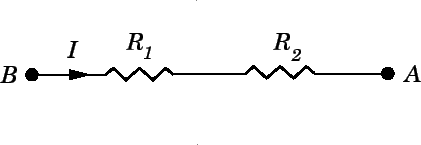- Joined
- Aug 27, 2014
- Messages
- 132
- Reaction score
- 18
Why does r1 go unaffected ? I'm not understanding the Berkeley review explanation 🙁

The voltage across the circuit, and across R1 and R2 will be the same. If it is a 10 V battery, the voltage before R1 is 10 and the voltage after R2 is 0. This does not change if another parallel resistor is added.
Second, the resistance across the R1, R2 branch stays the same. So if voltage and resistance stay the same, so does current.

Point B is 10 V before and after switch, point A is 0 V before and after switch, and R1 and R2 don't change.
Why doesn't resistance change when the switch is closed? I calculated it and got the total resistance of the circuit to decrease by a factor of 1/2
I think you are finding the equivalent resistors and representing the 5 resistors as 1, then finding the current through that equivalent resistor:Why doesn't resistance change when the switch is closed? I calculated it and got the total resistance of the circuit to decrease by a factor of 1/2


Why does the equivalent resistance decrease? I understand resistance in series is additive so its more when compared to parallel resistors that are reciprocal values. But aren't R1, R2, R3 , R4 already in parallel? So shouldn't adding R5 increase the equivalent resistance?What numbers are you using to determine that? There are no numbers given, so you cannot calculate an exact value. We can say with certainty that the equivalent resistance for the circuit will decrease (with the addition of a parallel resistor), but without any numbers we don't know by how much. We do know the drop in equivalent resistance will offset the increase in total current through the circuit, where the increase in total current equals the magnitude of current going through R5 after the switch is closed.
The question does not give numbers, so we need to consider that it has three independent pathways that have nothing in series before or after the junction. Starting from the cathode, V, the voltage must drop to 0V at the anode, so the voltage drop across all three parallel pathways must be equal to the voltage of the battery.
Neuroplasticity described this perfectly above.
If you happen to be familiar with the BR shortcut, I can do the calculation rather easily if you want me to include numbers. If you are not familiar with the shortcut, then math can be a bit cumbersome and might not be worth it.
